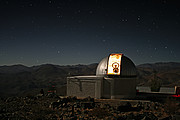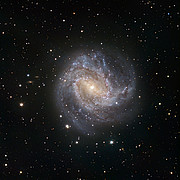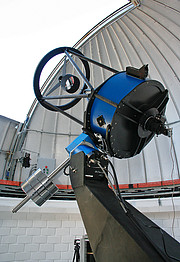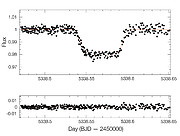Press Release
New National Telescope at La Silla
TRAPPIST to Scout the Sky and Uncover Exoplanets and Comets
8 June 2010
A new robotic telescope has had first light at ESO’s La Silla Observatory, in Chile. TRAPPIST (TRAnsiting Planets and PlanetesImals Small Telescope) is devoted to the study of planetary systems through two approaches: the detection and characterisation of planets located outside the Solar System (exoplanets) and the study of comets orbiting around the Sun. The 60-cm telescope is operated from a control room in Liège, Belgium, 12 000 km away.
“The two themes of the TRAPPIST project are important parts of an emerging interdisciplinary field of research — astrobiology — that aims at studying the origin and distribution of life in the Universe,” explains Michaël Gillon, who is in charge of the exoplanet studies.
“Terrestrial planets similar to our Earth are obvious targets for the search for life outside the Solar System, while comets are suspected to have played an important role in the appearance and development of life on our planet,” adds his colleague Emmanuël Jehin, who leads the cometary part of the project.
TRAPPIST will detect and characterise exoplanets by making high precision measurements of “brightness dips” that might possibly be caused by exoplanet transits. During such a transit, the observed brightness of the star decreases slightly because the planet blocks a part of the starlight. The larger the planet, the more of the light is blocked and the more the brightness of the star will decrease [1].
“ESO’s La Silla Observatory on the outskirts of the Atacama Desert is certainly one of the best astronomical sites in the world,” says Gillon. “And because it is already home to two superb exoplanet hunters, we couldn’t have found a better place to install our robotic telescope.”
The astronomers behind the TRAPPIST initiative will work very closely with the teams using HARPS on the 3.6-metre telescope and CORALIE attached to the Swiss 1.2-metre Leonhard Euler Telescope, both at La Silla. TRAPPIST is a collaboration between the University of Liège and the Geneva Observatory, Switzerland. The telescope is installed in the building that housed the old Swiss T70 telescope. Thanks to this collaboration, the whole project is on a fast track: it took only two years between taking the decision to build and first light.
TRAPPIST will also be used for the study of southern comets. To this aim, the telescope is equipped with special large, high quality cometary filters, allowing astronomers to study regularly and in detail the ejection of several types of molecules by comets during their journey around the Sun.
“With dozens of comets observed each year, this will provide us with a unique dataset, bringing important information about their nature,” says Jehin.
TRAPPIST is a lightweight 0.6-metre robotic telescope, fully automated and moving precisely across the sky at a high speed. The observing programme is prepared in advance and the telescope can perform a full night of observations unattended. A meteorological station monitors the weather continuously and decides to close the dome if necessary.
Notes
[1] A planetary transit occurs when a celestial body passes in front of its host star and blocks some of the star’s light. This type of eclipse causes changes in the apparent brightness of the star and enables the planet’s diameter to be measured. Combined with radial velocity measurements, it is also possible to deduce the mass and, hence, the density of the planet.
More information
TRAPPIST (TRAnsiting Planets and PlanetesImals Small Telescope) is a project led by the Department of Astrophysics, Geophysics and Oceanography (AGO) of the University of Liège (Belgium), in close collaboration with the Observatory of Geneva (Switzerland). TRAPPIST is mostly funded by the Belgian Fund for Scientific Research (FNRS) with the participation of the Swiss National Science Foundation (SNF).
The team is composed of Emmanuël Jehin, Michaël Gillon, Pierre Magain, Virginie Chantry, Jean Manfroid, and Damien Hutsemékers (University of Liège, Belgium) and Didier Queloz and Stéphane Udry (Observatory of Geneva, Switzerland).
The name TRAPPIST was given to the telescope to underline the Belgian origin of the project. Trappist beers are famous all around the world and most of them are Belgian. Moreover, the team members really appreciate them!
Links
Contacts
Emmanuël Jehin
University of Liège
Liège, Belgium
Tel: +32 4 366 97 26
Email: ejehin@ulg.ac.be
Didier Queloz
Geneva Observatory, University of Geneva
Geneva, Switzerland
Tel: +41 22 379 2477
Email: didier.queloz@unige.ch
Henri Boffin
ESO, La Silla Paranal and E-ELT Press Officer
Garching, Germany
Tel: +49 89 3200 6222
Cell: +49 174 515 43 24
Email: hboffin@eso.org
Michaël Gillon
University of Liège
Liège, Belgium
Tel: +32 4 366 97 43
Email: michael.gillon@ulg.ac.be
Pierre Magain
University of Liège
Liège, Belgium
Tel: +32 4 366 97 43
Email: pierre.magain@ulg.ac.be
About the Release
| Release No.: | eso1023 |
| Name: | 30 Doradus, NGC 2070, Tarantula Nebula |
| Type: | Local Universe : Nebula : Appearance : Emission : H II Region |
| Facility: | TRAnsiting Planets and PlanetesImals Small Telescope–South |






